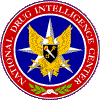List of Figures
Figure 1. Six Regional
Areas
Figure 2. Greatest Drug Threat
Figure 3. Greatest Drug Threat by Region
Figure 4. Regional Drug Availability
Figure 5. Primary Market Areas
Figure 6. Cocaine Flows to the United
States
Figure 7. Primary Market Areas: Cocaine
Figure 8. Primary Domestic Methamphetamine
Production Areas
Figure 9. Primary Market Areas:
Methamphetamine
Figure 10. Outdoor Cannabis
Cultivation Areas
Figure 11. Primary
Market Areas: Marijuana
Figure 12. Primary Market Areas: Heroin
Figure 13. Primary Market Areas: MDMA |
List of Tables
Table 1. POEs Along
U.S.-Mexico Border With Marijuana Seizures of 1,000+ Kilograms, 2002
Table A1. NDTS 2003
Sample Design (3,354 of 3,488 agencies responding)
Table A2. NDTS 2003 Response
Rates
Table B1. NSDUH:
Percentage of Respondents Reporting Use of Specific Drugs in Lifetime,
Past Year, and Past Month by Age Group, 2003
Table B2. MTF: Trends in Lifetime
Prevalence of Use of Various Drugs for Eighth, Tenth, and Twelfth Graders,
1998-2003 (%)
Table B3. MTF: Trends in Past Year
Prevalence of Use of Various Drugs for Eighth, Tenth, and Twelfth Graders,
1998-2003 (%)
Table B4. MTF: Trends in Current
Prevalence of Use of Various Drugs for Eighth, Tenth, and Twelfth Graders,
1998-2003 (%)
Table B5. PRIDE: Percentage of Past
Year Drug Use by Junior and Senior High School Students and Twelfth
Graders, 1998-1999 through 2002-2003 School Years
Table B6. PRIDE: Percentage of Current
Drug Use by Junior and Senior High School Students and Twelfth Graders,
1998-1999 through 2002-2003 School Years
Table B7. DAWN: Estimated Number of
Emergency Department Drug Mentions and Mentions of Selected Drugs by Year,
1995-2002
Table B8. TEDS: Number of Treatment
Admissions and Admissions by Selected Substances of Abuse, 1994-2000 |
From the Director:
I am pleased to present the National Drug Threat Assessment 2004.
This annual report is designed to provide policymakers and law enforcement
personnel with information to help in formulating counterdrug policy,
establishing law enforcement priorities, and allocating resources.
The National Drug Intelligence Center produces the National Drug Threat
Assessment in partnership with federal, state, and local agencies. To
accurately and reliably depict the current domestic drug situation, the
report integrates the most recently available reporting from law
enforcement and intelligence agencies with the most current data from
public health agencies regarding national substance abuse indicators. This
year's report also draws on information from more than 3,300 state and
local law enforcement agencies that responded to our National Drug Threat
Survey 2003 as well as thousands of personal interviews with law
enforcement and public health officials.
My thanks to all participating agencies and organizations whose
contributions have made the National Drug Threat Assessment possible. Your
continued assistance has been invaluable in producing this assessment
annually.
I encourage you to review the National Drug Threat Assessment 2004
and provide feedback on the enclosed Reader Comment
Card (pdf). Your views and opinions are
important and help us to best meet the needs of our clients. I appreciate
your past cooperation and look forward to collaborating on future
projects.
Michael T. Horn
April 2004
|
|
National Drug Intelligence Center
319 Washington Street, 5th Floor
Johnstown, PA 15901
Tel. (814) 532-4601
FAX (814) 532-4690
E-mail cmbwebmgr@ndic.osis.gov |
National Drug Intelligence Center
8201 Greensboro Drive, Suite 1001
McLean, VA 22102-3840
Tel. (703) 556-8970
FAX (703) 556-7807
|
![]()

